
Latrodectus is a broadly distributed genus of spiders with several species that are commonly known as the true widows. This group is composed of those often loosely called black widow spiders, brown widow spiders, and similar spiders. However, the diversity of species is much greater. A member of the family Theridiidae, this genus contains 34 species, which include several North American "black widows". Besides these, North America also has the red widow Latrodectus bishopi and the brown widow Latrodectus geometricus, which, in addition to North America, has a much wider geographic distribution. Elsewhere, others include the European black widow, the Australian redback spider and the closely related New Zealand katipō, several different species in Southern Africa that can be called button spiders, and the South American black-widow spiders. Species vary widely in size. In most cases, the females are dark-coloured and can be readily identified by reddish markings on the central underside (ventral) abdomen, which are often hourglass-shaped.

Gasteracantha is a genus of orb-weaver spiders first named by Carl Jakob Sundevall in 1833. Species of the genus are known as spiny-backed orb-weavers, spiny orb-weavers, or spiny spiders. The females of most species are brightly colored with six prominent spines on their broad, hardened, shell-like abdomens. The name Gasteracantha is derived from the Greek gaster (γαστήρ), meaning "belly, abdomen", and akantha (άκανθα), meaning "thorn, spine". Spiny-backed orb-weavers are sometimes colloquially called "crab spiders" because of their shape, but they are not closely related to the true crab spiders. Other colloquial names for certain species include thorn spider, star spider, kite spider, or jewel spider.
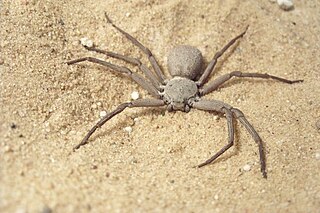
Sicarius is a genus of recluse spiders that is potentially medically significant to humans. It is one of three genera in its family, all venomous spiders known for a bite that can induce loxoscelism. They live in deserts and arid regions of the Neotropics, and females use a mixture of sand and silk when producing egg sacs. The name is Latin for assassin.
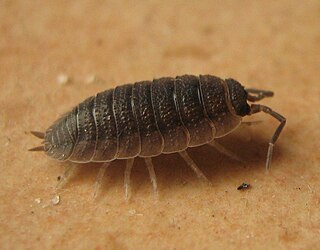
Porcellio is a genus of woodlice in the family Porcellionidae. These crustaceans are found essentially worldwide. A well-known species is the common rough woodlouse, Porcellio scaber.

Euspira is a genus of medium-sized sea snails, marine gastropod molluscs in the subfamily Polinicinae of the family Naticidae, the moon snails.

Isotomidae is a family of elongate-bodied springtails in the order Entomobryomorpha.

Tomocerus is a genus of springtails described by Nicolet in 1841.
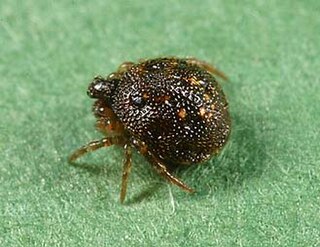
Phoroncidia is a genus of comb-footed spiders that was first described by J. O. Westwood in 1835.
Oxysoma is a genus of South American anyphaenid sac spiders first described by H. Nicolet in 1849.
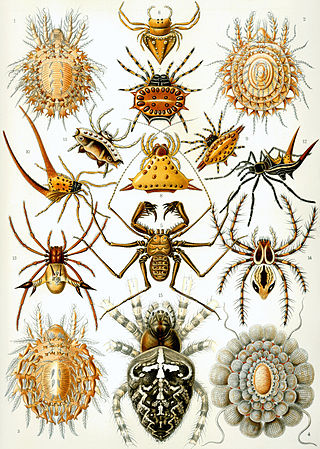
Gnolus is a genus of South American orb-weaver spiders that was first described by Eugène Louis Simon in 1879. Originally placed with the orb-weaving spiders, it was transferred to the pirate spiders in 1993, but moved back to orb-weaver family in 2012.
Diphya is a genus of long-jawed orb-weavers that was first described by H. Nicolet in 1849. D. tanasevitchi and D. albulum were transferred from Lophomma in 2007.
Heterognatha is a genus of South American orb-weaver spiders containing the single species, Heterognatha chilensis. It was first described by H. Nicolet in 1849, and has only been found in Chile.

Kochiura is a genus of comb-footed spiders that was first described by Allan Frost Archer in 1950.
Coenypha is a genus of South American crab spiders that was first described by Eugène Louis Simon in 1895.
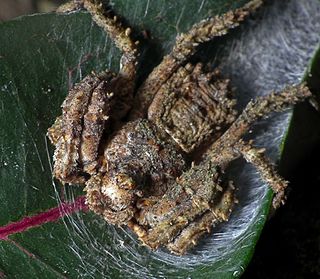
Stephanopis is a genus of crab spiders first described by Octavius Pickard-Cambridge in 1869. It was erected for five then newly described species, including S. altifrons, from Australia. Stephanopis was characterized by the high cephalic region with unequally sized anterior eyes disposed in a strongly recurved row, opisthosoma ending in several spiniform projections and dorsoventrally depressed habitus. According to Pickard-Cambridge, the single specimen used for the description of S. altifrons was dry-pinned. Therefore the specimen could not be properly examined, so it was not possible to determine if the specimen was adult. Moreover, he states his own sketch of the spider as “hasty” or "dull". This may explain why the somatic characters were inadequately described, genitalic features were not mentioned at all, and the illustrations were not detailed enough, making the species unidentifiable.

Entomobrya lanuginosa is a species of springtail in the genus Entomobrya.
Tanais is a genus of malacostracans in the family Tanaididae. There are about 11 described species in Tanais.

Allende is a genus of South American long-jawed orb-weavers that was first described by F. Álvarez-Padilla in 2007.
Selkirkiella is a genus of South American comb-footed spiders that was first described by Lucien Berland in 1924. Originally placed with the Araneidae, it was transferred to the comb-footed spiders in 1972.
Gasteracantha flava is a species of spider described in 1849 from Chile. The spider's abdomen bears 14 spines and is yellow in color with brown or black sigilla and a strongly wrinkled ventral side. The World Spider Catalog currently treats this taxon as a spiny orb-weaver spider in the genus Gasteracantha. In 1849, H. Nicolet included it in the genus Gasteracantha along with 18 other species he described from Chile. Nicolet described G. flava as being closely allied to another species described at the same time, Gasteracantha spissa, which had the same number and shape of spines and was very similar. Subsequent authors refined Nicolet's species, and in a 1996 publication Herbert Levi wrote, "All Nicolet's species seem to belong in Phoroncidia (Theridiidae)." Levi transferred the 14-spined taxon spissa, described by Nicolet as very similar to G. flava, to the genus Phoroncidia, creating the new combination Phoroncidia spissa. However, Levi did not explicitly address G. flava, so it remains in Gasteracantha as of November 2019, though its purported sister species now belongs to Phoroncidia and no other Gasteracantha species has more than six spines.












